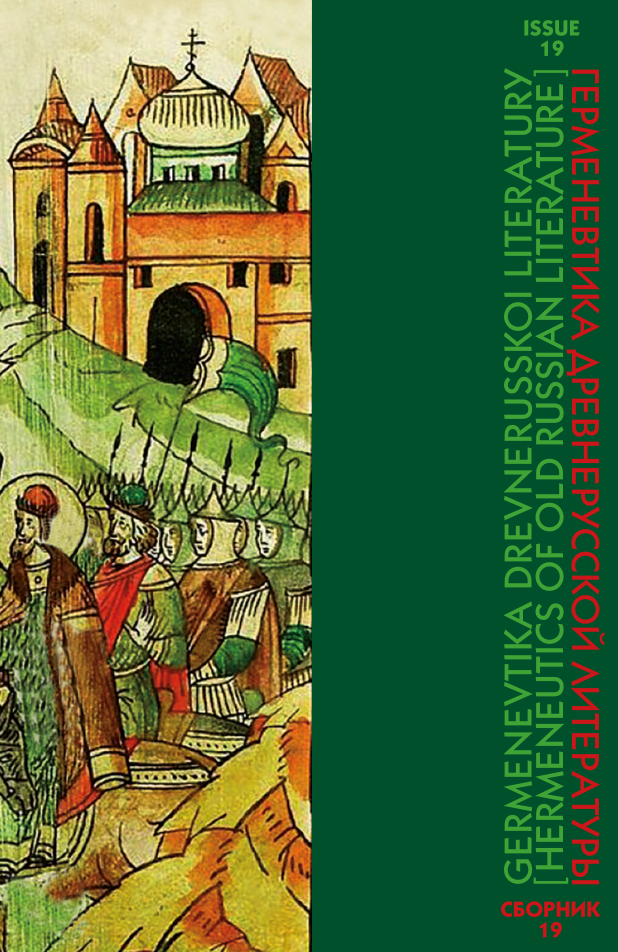Abstract:
The article considers the descriptions of Kuvuklion, the main Christian memorial, which are contained in Old Russian travel notes compiled by Russian pilgrims who visited Jerusalem from the 12th to the 17th centuries. The comparison of these descriptions with each other, as well as partly with similar descriptions of Greek pilgrims and Western pilgrims, reveals the specifics of attitude of Russian travelers as observers and storytellers to the described holy relic. The latter, with varying completeness and degree of attention to particulars, but methodically sought to create a visual image of the Kuvuklia in the imagination of their readers, to develop a more or less clear, objectively detailed idea of it, remaining in the exclusively business discourse in stylistic terms, which in no way reflects spiritual and emotional experiences and aesthetic impressions, which could well color their perception at the moment of direct communion with shrine. Accordingly, the goals of their appeal to readers as a verbal presentation of a specific subject phenomenon in the Holy Land without any expression about it, which was probably considered superfluous, were determined by the same restrained business nature. At the same time, when comparing the texts, it is found that the expression “Holy Sepulcher” was originally used polysemically in the wide speech space of Middle Ages, gradually acquires a more specific meaning, which is undoubtedly a reflex of a certain speech development.
REFERENCES
1 Arkhipov, A. “O proiskhozhdenii drevnerusskikh khozhdenii” [“On the Origin of Old Russian Traveling”]. Trudy po znakovym sistemam [Works on Sign Systems], vol. XV: Tipologiia kul’tury. Vzaimodeistvie kul’tur [Typology of Culture. Interaction of Cultures]. Tartu, Tartu State University Publ., 1982, pp. 103–109. (In Russian)
2 Branitskii, A.G., Kornilov, A.A. Religii regiona [Religions of Region]. N. Novgorod, NNGU imeni N. I. Lobachevskogo Publ., 2013. 305 p. (In Russian)
3 Granovskii, A. N. Krestovye pokhody. V 2-kh t. T. 2: Kniga tret’ia. Poslednie krestovye pokhody (1202–1270) [Crusades: in 2 vols., vol. 2: Book Three. Last Crusades (1202– 1270)]. St. Petersburg, Dmitrii Bulanin Publ., 2013. 288 p. (In Russian)
4 Guminskii, V.M. “‘Khozhenie’ igumena Daniila i razvitie palomnicheskoi literatury (Prostranstvo i vremia)” [“‘Old Russian Traveling’ of Father Superior Daniel and the Development of Pilgrimage Literature (Space and Time)”]. Guminskii, V. M. Russkaia literatura puteshestvii v mirovom istoriko-kul’turnom kontekste [Russian Travel Literature in the World Historical and Cultural Context], Moscow, IWL RAS Publ., 2017, pp. 67–130. (In Russian)
5 Danilov, V.V. “O zhanrovykh osobennostiakh drevnerusskikh khozhdenii” [On the Genre Features of Old Russian Traveling”]. Trudy Otdela drevnerusskoi literatury [Proceedigs of the Department of Old Russian Literature], vol. XVIII. Moscow, Leningrad, AN SSSR Publ., 1962, pp. 21–37. (In Russian)
6 Zhitenev, S.Iu. Istoriia russkogo pravoslavnogo palomnichestva v X–XVIII vekakh [History of Russian Orthodox Pilgrimage in the 11th–18th Centuries]. Moscow, Indrik Publ., 2007. 480 p. (In Russian)
7 Konradi, V.G. Kniga o sviatom Frantsiske [Book of St. Francis]. St. Petersburg, Ogni Publ., 1912. 241 p. (In Russian)
8 Levshun, L.V. O slove preobrazhennom i slove preobrazhaiushchem: Teoretikoanaliticheskii ocherk istorii vostochnoslavianskogo knizhnogo slova XI—XVII vekov [On the Word Transformed and the Word Transforming: a Theoretical and Analytical Sketch of History of the East Slavic Book Word of the 11th–17th Centuries]. Minsk, Belorusskaia Pravoslavnaia Tserkov’ Publ., 2009. 896 p. (In Russian)
9 Maleto, E.I. “Russkie srednevekovye khozhdeniia v otechestvennoi i zarubezhnoi istoriografii. Istoriia i perspektivy izucheniia” [“Russian Medieval Traveling in Russian and Foreign Historiography. History and Prospects of Study”]. Trudy Instituta rossiiskoi istorii RAN [Proceedings of the Institute of Russian History of the Russian Academy of Sciences], no. 5. Moscow, Nauka Publ., 2005, pp. 38–63. (In Russian)
10 Marotstsi, Dzh. Tamerlan: Zavoevatel’ mira [Tamerlane: Conqueror of the World], trans. from Engl. A.G. Bol’nykh. Moscow, AST [etc.] Publ., 2010. 445, [3] p. (In Russian)
11 Nazarenko A.V. Drevniaia Rus’ i slaviane (istoriko-filologicheskie issledovaniia) [Old Russia and the Slavs (Historical and Philological Research)]. Moscow, Russkii Fond Sodeistviia Obrazovaniiu i Nauke Publ., 2009. 528 p. (In Russian)
12 Prokof ’ev, N. I. “Russkie khozhdeniia XII-XV vv.” [“Russian Traveling of the 12th–15th Centuries”]. Literatura Drevnei Rusi i XVIII v. [Literature of Old Russia and the 18th Century. Moscow, 1970, pp. 3–264. (Scientific Notes of the Lenin Moscow State Pedagogical Institute, no. 363) (In Russian)
13 Ransimen, S. Osnovanie Ierusalimskogo korolevstva: Glavnye etapy Pervogo krestovogo pokhoda, Perev. s angl. T. M. Shulikovoi [Founding of Jerusalem Kingdom: the Main Stages of the First Crusade, trans. from Engl. by T.M. Shulikov]. Moscow, Tsentrpoligraf Publ., 2020. 287 p. (In Russian)
14 Sedov, V.V. “Umnozhenie skhodnykh velichin: Monastyr’ Pantokratora v Konstantinopole” [“Multiplication of Similar Values: Monastery of Pantokrator in Constantinople”]. Proekt-klassika. IX-MMIII. Internet-izdanie [Project-Classics. IX-MMIII. Internet edition]. 27.01.2004. Available at: http://www.projectclassica.ru/v_o/09_2003/09_2003_o_03a.htm (Acessed 10 July 2021). (In Russian)
15 Seleznev, N.N. “Interpretatsii proiskhozhdeniia nazvaniia ‘iakovity’ u srednevekovykh araboiazychnykh egipetskikh avtorov” [“Interpretations of the Origin of Name ‘Yakovite’ in Medieval Arabic-speaking Egyptian Authors”]. Vestnik RGGU: Seriia “Vostokovedenie, afrikanistika” [Bulletin of the Russian State University for the Humanities: Series “Oriental Studies,” African Studies], vol. 100, no. 20, 2012, pp. 153–168. (In Russian)
16 Uspenskii, F.I. Istoriia krestovykh pokhodov [History of the Crusades]. St. Petersburg, Evraziia Publ., 2000. 384 p. (In Russian)
17 Denke, Andrea. “Konrad Grunemdergs Pilgerreise ins Heilige Land 1486: Untersuchung, Edition und Kommentar.” Stuttgarter Historische Forschungen, Vol. 11. Koln, Bohlau Verlag, 2010. 615 S. (In German)
18 Stavrou, Theofanis George, Weisensel, Peter R. Russian Travelers to the Christian East from the Twefth to the Twentieth Century. Columbus, Ohio, Slavca Publishers, 1986. 925 p. (In English)






